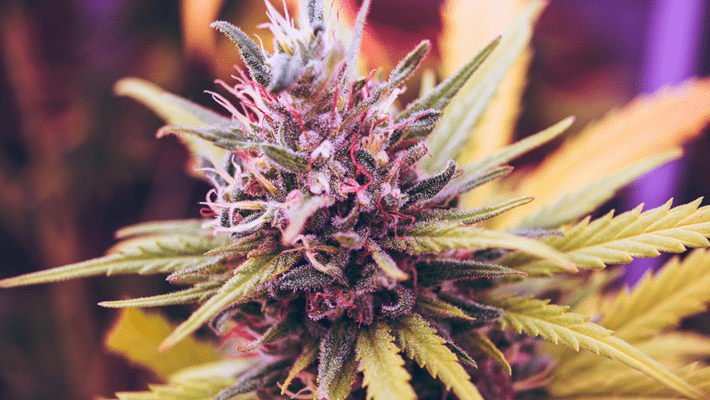
What are Flavonoids in Marijuana?
Published on 3/14/21
Terpenes and cannabinoids seem to get all the attention when it comes to cannabis, but flavonoids are an important part of the plant, too. You might be wondering, What is a flavonoid? Dont worry, youre not the only one. A lot of people are unfamiliar with flavonoids and cannaflavins, even though they are much more relevant and naturally occurring. Because they are so important, and not just in cannabis, weve created this article to help you better understand flavonoids. Read on to learn more about flavonoids in marijuana, where else they occur, how they work and why they are so important.
What Are Flavonoids?
 @knf_garden via Instagram
@knf_garden via InstagramCannabis is composed of over 400 chemical entities. It is a complex plant that affects the human body in many different ways, with the various chemical compounds working in tandem to create the overall medicinal and psychoactive effects we associate with marijuana. One of the more important compounds within cannabis is the flavonoid, a naturally occurring polyphenolic compound found in almost every fruit and vegetable, along with various flowers. Flavonoids are phytonutrients (plant chemicals) largely responsible for the vibrant colors of fruits and vegetables.
Additionally, while widely understudied, flavonoids are thought to directly decrease inflammation and help reduce the risk of cancer, cardiovascular disease and neurodegenerative disorders. Some within the cannabis industry are suggesting that flavonoids may be the next big thing in medical marijuana, with studies indicating that they may also be an incredibly viable pain killer, up to 30 times more powerful than aspirin. They are powerful and there are a lot of them. Even with limited research, in total, scientists have discovered more than 6,00 types of flavonoids.
What Are Cannaflavins?
While there are thousands of known flavonoids, there are some only found in cannabis. These flavonoids in marijuana are called cannaflavins, and they are also responsible for the pigmentation and vibrant colors found in different strains of cannabis. Terpenes are given credit for the flavors and aromas found in all different strains of marijuana, but cannaflavins are thought to also help produce these. Terpenes and cannaflavins share various qualities that result in the synergetic creation of certain aromas and flavors. There are several known types of cannaflavin with cannabis. Cannaflavin A and B are both prenylated flavonoids unique to cannabis that are thought to be pharmacologically active with the ability to aid the body in the same way as other flavonoids found within fruits and vegetables. Other types have been researched less, such as cannaflavin C, which is also thought to potentially hold various medicinal benefits.
Flavonoids and the Entourage Effect
 Unsplash
UnsplashAnother increasingly exciting aspect of cannabis is the entourage effect, a phenomenon that has become a major talking point within the cannabis industry over the last few years. As addressed, while flavonoids play a large role in the composition of cannabis, they are not the only important part of the plant. With over 400 distinct chemical compounds, the effects of cannabis are produced through a complex synthesis of uniquely distinct compounds. When consumed, the holistic marijuana experience created through this massive synthesis of compounds is called the entourage effect.
Cannabinoids within cannabis, such as CBD and THC, directly interact with our bodys Endocannabinoid System, a system of receptors found in almost every part of our body. We know that THC interacts with CB1 and CB2 receptors, causing psychoactive effects and euphoria, while CBD binds with the CB2 receptor to create relaxation and other effects, along with helping dial down the psychoactive effects of THC. This is a major part of the entourage effect that scientists have discovered through recent studies, but the equally synergetic qualities of terpenes and flavonoids underline that they also likely play a part in this larger entourage effect. To better understand how flavonoids interact with cannabinoids and produce the overall marijuana experience, we need more research.
The Need for More Research
Because of marijuanas federal classification as an illicit Schedule I drug, cannabis studies have historically been very limited. With increased legalization in recent years, marijuana studies continue to increase, but there is still a ton we dont know about marijuana. Along with a better understanding of THC, CBD, THCV, CBG and a myriad of other elements within cannabis we know little about, a major focus in future studies will likely be flavonoids and cannaflavins. As a naturally occurring compound already scientifically thought to have major medicinal benefits, knowing how flavonoids and other aspects of cannabis interact and affect us through the entourage effect could have a massive impact on the future of medicinal marijuana. Do flavonoids help with pain relief? How effective are flavonoids again inflammation and preventing chronic conditions, cancer and other major medical conditions? The sooner we can answer the question, how do flavonoids work, the sooner we understand just how beneficial marijuana may be.
There are a lot of other important parts to marijuana that people dont know about. Join the conversation and comment below on other interesting facts about weed and how it works.
